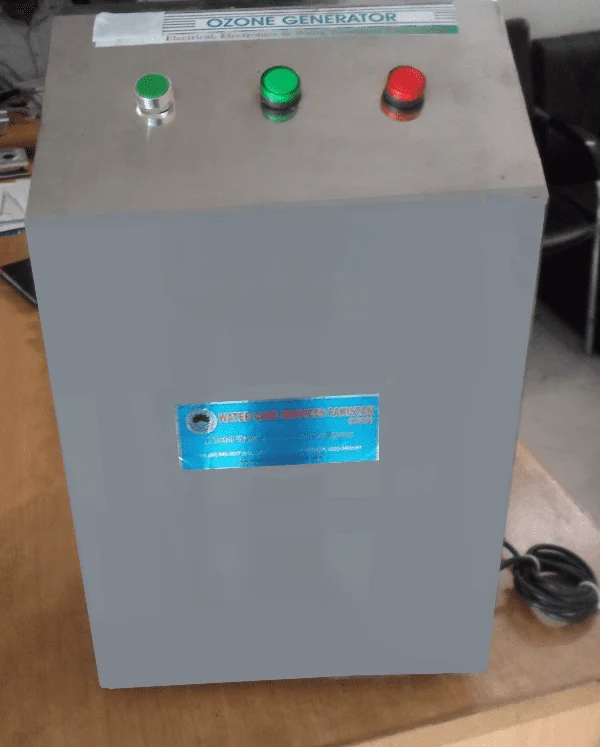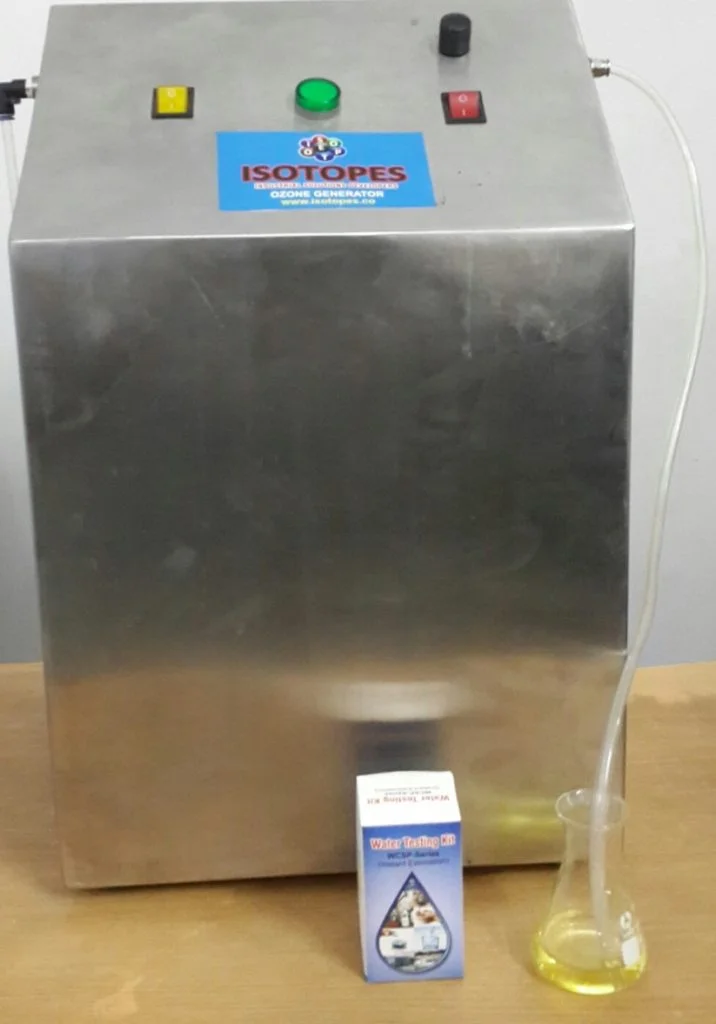Ozone Generator
Advantages of Chlorination in Water Treatment
Chlorination is a highly reliable and professionally proven method for water disinfection, recognized for its effectiveness in eliminating harmful pathogens such as bacteria, viruses, and other microorganisms. Its consistent track record in safeguarding public health has made chlorination a fundamental component of modern water treatment systems. Its versatility allows it to be seamlessly applied across a wide range of settings, including municipal water supplies, industrial facilities, and community-level applications—making it one of the most trusted and adaptable solutions for clean and safe water.
How Is Ozone produced?
Feed gas preparatory:
The feed gas can consist of either dry air or concentrated oxygen. Dry air is defined as air that has been dried to a dew point of -60°F or lower.
Concentrated oxygen refers to a purified gas containing a minimum of 90% oxygen, with all moisture thoroughly eliminated to ensure optimal performance in specialized applications.
Power input:
The primary power demand arises from the conversion of oxygen into ozone. Supplementary power needs encompass the preparation of feed gas, the ozone contact process, as well as the power necessary for control, instrumentation, and monitoring facilities.
Ozone generating device:
Ozone is typically generated on-site for disinfection purposes using a corona discharge method. The ozone is produced by applying high voltage between closely spaced electrodes, using either air or concentrated oxygen as the source.
The high-energy corona, generated through the process mentioned above, separates one oxygen molecule, which then combines with two other oxygen molecules to form an ozone molecule.
Using ambient air as the feed gas, this method generates an ozone concentration ranging from 1–3% by weight. When pure oxygen is used instead, the resulting ozone concentration increases significantly—typically between 3–10% by weight.
Contact basin:
The most critical process during use of ozone as the disinfectant is the proper mixing of ozone in the water. Two types of systems are used for this purpose i.e. ozone transfer via bubble diffusion or venture.
Bubble diffusion refers to the ozone transferred by diffusers. The diffusers create small bubbles of ozone in water. As the bubble rises, the gas at the edge of the bubbles will transfer into the water.
Venturi injection system work by forcing water through the conical body. This process creates a pressure differential between inlet and outlet ports resulting in a vacuum inside the injector body.
This vacuum effect enables the swift induction of ozone through the designated suction port, ensuring efficient mixing within the system.
Feed gas preparatory:
The feed gas can consist of either dry air or concentrated oxygen. Dry air is defined as air that has been dried to a dew point of -60°F or lower.
Concentrated oxygen refers to a purified gas containing a minimum of 90% oxygen, with all moisture thoroughly eliminated to ensure optimal performance in specialized applications.
Power input:
The primary power demand arises from the conversion of oxygen into ozone. Supplementary power needs encompass the preparation of feed gas, the ozone contact process, as well as the power necessary for control, instrumentation, and monitoring facilities.
Ozone generating device:
Ozone for water disinfection is typically produced on-site using the corona discharge method. High voltage applied between closely spaced electrodes—using air or concentrated oxygen—creates a high-energy corona that splits oxygen molecules, which then recombine to form ozone. When ambient air is used, ozone concentrations typically range from 1–3% by weight, while using pure oxygen increases concentrations to 3–10%, providing a highly effective and controlled disinfection solution for industrial and commercial applications.
Contact basin:
The most critical process during use of ozone as the disinfectant is the proper mixing of ozone in the water. Two types of systems are used for this purpose i.e. ozone transfer via bubble diffusion or venture.
Bubble diffusion refers to the ozone transferred by diffusers. The diffusers create small bubbles of ozone in water. As the bubble rises, the gas at the edge of the bubbles will transfer into the water.
Venturi injection system work by forcing water through the conical body. This process creates a pressure differential between inlet and outlet ports resulting in a vacuum inside the injector body.
This vacuum effect enables the swift induction of ozone through the designated suction port, ensuring efficient mixing within the system.
Ozone for water disinfection is typically produced on-site using the corona discharge method. High voltage applied between closely spaced electrodes—using air or concentrated oxygen—creates a high-energy corona that splits oxygen molecules, which then recombine to form ozone. When ambient air is used, ozone concentrations typically range from 1–3% by weight, while using pure oxygen increases concentrations to 3–10%, providing a highly effective and controlled disinfection solution for industrial and commercial applications.


Ensure Safe and Clean Water—Talk to Our Experts
Advantages:
Powerful Disinfectant: Ozone is a strong oxidizing agent, making it effective in killing bacteria, viruses, and fungi.
Air Purification: Ozone generators can eliminate odors and improve air quality by breaking down pollutants.
Water Treatment: Ozone is used for water purification, effectively removing contaminants.
Chemical-Free: Ozone generators do not require the use of additional chemicals for their disinfectant properties.
Disadvantages:
Health Risks: High concentrations of ozone can be harmful to humans and pets, causing respiratory issues and other health problems.
Limited Residual Effect: Ozone has a short half-life and may not provide long-lasting disinfection.
Regulatory Restrictions: Some regions have regulations on the use of ozone generators, especially in indoor environments, due to health concerns.
Ineffectiveness in Certain Conditions: Ozone may be less effective in high humidity or in the presence of certain organic materials.
An ozone generator is a device that produces ozone, a molecule composed of three oxygen atoms. It works by using electrical discharges or UV light to break apart oxygen molecules, creating ozone.
Ozone generators are used for air and water purification, odor control, food preservation, and various industrial processes. They are also employed in medical settings for disinfection.
While ozone is an effective disinfectant, high concentrations can be harmful. It’s crucial to use ozone generators in accordance with safety guidelines and ensure that occupied spaces are properly ventilated.
Yes, ozone generators are known for their ability to neutralize and eliminate odors by oxidizing the molecules causing the unpleasant smells.
The time required depends on factors such as the size of the space or volume of water, ozone concentration, and the specific application. Generally, ozone acts quickly, but treatment times can vary.
Regular maintenance, such as cleaning ozone-producing elements and checking for any malfunctions, is recommended. Follow the manufacturer’s guidelines for optimal performance.
Yes, ozone generators are effective in eliminating mold and mildew. However, it’s essential to follow proper procedures and ensure that the treated area is well-ventilated before reoccupying.
Users should follow safety guidelines provided by the manufacturer, including avoiding prolonged exposure to high ozone concentrations, ensuring adequate ventilation, and using the device in unoccupied spaces.
Ozone generators may have limitations in treating certain types of pollutants or contaminants. Understanding the specific capabilities of the generator in relation to the intended application is crucial.
Yes, ozone generators are commonly used for water treatment to disinfect and remove impurities. They are effective in eliminating bacteria, viruses, and other microorganisms in water.
